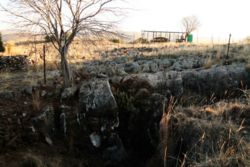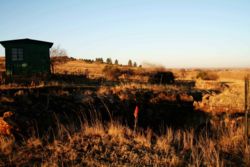Kromdraai Cave: Difference between revisions
imported>Lee R. Berger (adding additional text and cz live) |
mNo edit summary |
||
| (8 intermediate revisions by 6 users not shown) | |||
| Line 1: | Line 1: | ||
'''Kromdraai''' (26 00'S, 27 45'E) is a fossil-bearing breccia filled cave located about 2km east of the well known South African hominid-bearing site of [[Sterkfontein]] and about 45km Northwest of the City of [[Johannesburg]], [[South Africa]]. It is situated within the [[Cradle of Humankind]] [[World Heritage | {{subpages}} | ||
'''Kromdraai''' (26 00'S, 27 45'E) is a fossil-bearing breccia filled cave located about 2km east of the well known South African hominid-bearing site of [[Sterkfontein]] and about 45km Northwest of the City of [[Johannesburg]], [[South Africa]]. It is situated within the [[Cradle of Humankind]] [[World Heritage site]]. | |||
==History of | ==History of investigations== | ||
In 1938 | In 1938 the site was brought to the attention of [[Robert Broom]] by a local schoolboy named Gert Terrblanche who had discovered several hominin teeth. The teeth formed part of a skull that would become the [[holotype]] of ''[[Paranthropus robustus]]''. Broom began excavations at the site that would continue until approximately 1947 and would result in the discovery of numerous hominin remains as well as thousands of fossil animals. Two deposits were noted and named at the site - Kromdraai A and Kromdraai B - the latter being the site where the hominin remains were recovered<ref name="Broom">{{cite book|title=finding the Missing Link|accessdate=|author=R. Broom|authorlink= |coauthors= |date=1950 |format= |work= |publisher=Watts, London|pages= |language= |archiveurl= |archivedate= |quote= }}</ref>. {{Image|Kromdraai A.jpg|left|250px|Kromdraai A viewed from the Southwest in 2007.}} | ||
In 1955 [[Charles Kimberlin Brain|C.K. Brain]] recommenced work at Kromdraai B and discovered numerous additional hominin remains as well as abundant non-hominin fauna<ref name="Thackeray">{{cite book|title=Hominid fossils from Kromdraai: a revised list of specimens discovered since 1938|accessdate=|author=J.F. Thackeray, D.J. de Ruiter, L.R. Berger and N.J. van der Merve |authorlink= |coauthors= |date=2001 |format= |work= |publisher=Annals of the Transvaal Museum 38|pages= 43-56|language= |archiveurl= |archivedate= |quote= }}</ref>. | In 1955 [[Charles Kimberlin Brain|C.K. Brain]] recommenced work at Kromdraai B and discovered numerous additional hominin remains as well as abundant non-hominin fauna<ref name="Thackeray">{{cite book|title=Hominid fossils from Kromdraai: a revised list of specimens discovered since 1938|accessdate=|author=J.F. Thackeray, D.J. de Ruiter, L.R. Berger and N.J. van der Merve |authorlink= |coauthors= |date=2001 |format= |work= |publisher=Annals of the Transvaal Museum 38|pages= 43-56|language= |archiveurl= |archivedate= |quote= }}</ref>. {{Image|Kromdraai B.jpg|right|250px|Kromdraai B viewed from the Northeast in 2007.}} | ||
In 1980's [[Elizabeth Vrba]] briefly conducted excavations at Kromdraai B in order to recover additional samples for her work on South African bovids<ref name="Vrba">{{cite book|title=The Kromdraai Australopithecine site revisted in 1980: recent investigations and results|accessdate=|author=E. Vrba|authorlink= |coauthors= |date=1981 |format= |work= |publisher=Annals of the Transvaal Museum|pages= 17-60 |language= |archiveurl= |archivedate= |quote= }}</ref>. Her excavations were by far the most extensive since Robert Broom's. This work also recovered a number hominid fossils and her excavations formed the basis of much of the present understanding of the geology of the site. It was this work that spurred the first cores to be drilled at the site and resulting | In 1980's [[Elizabeth Vrba]] briefly conducted excavations at Kromdraai B in order to recover additional samples for her work on South African bovids<ref name="Vrba">{{cite book|title=The Kromdraai Australopithecine site revisted in 1980: recent investigations and results|accessdate=|author=E. Vrba|authorlink= |coauthors= |date=1981 |format= |work= |publisher=Annals of the Transvaal Museum|pages= 17-60 |language= |archiveurl= |archivedate= |quote= }}</ref>. Her excavations were by far the most extensive since Robert Broom's. This work also recovered a number hominid fossils and her excavations formed the basis of much of the present understanding of the geology of the site. It was this work that spurred the first cores to be drilled at the site and resulting analysis showed that there were caves still present below the site. | ||
| Line 18: | Line 19: | ||
Stone tools have been discovered at Kromdraai A by Thackeray's teams. However, no artefacts have been discovered in Kromdraai B where the hominin fossils have been discovered. | Stone tools have been discovered at Kromdraai A by Thackeray's teams. However, no artefacts have been discovered in Kromdraai B where the hominin fossils have been discovered. | ||
==Recovered | ==Recovered fossils== | ||
Besides the holotype specimen of ''P. robustus'', at the time of the writing of this article 29 hominin specimens had been recovered from Kromdraai B <ref name="Thackeray"/>. Many thousands of animal fossils have also been recovered from both Kromdraai A and B. | Besides the holotype specimen of ''P. robustus'', at the time of the writing of this article 29 hominin specimens had been recovered from Kromdraai B <ref name="Thackeray"/>. Many thousands of animal fossils have also been recovered from both Kromdraai A and B. | ||
| Line 28: | Line 29: | ||
*''[[Pachycrocuta bellax]]'' | *''[[Pachycrocuta bellax]]'' | ||
====Age of the | ====Age of the deposits==== | ||
Kromdraai B is dated to | Kromdraai B is dated to approximately 1.6 - 1.9 mya<ref name="Thackeray"/>. | ||
==References== | ==References== | ||
{{reflist}}[[Category:Suggestion Bot Tag]] | |||
{{reflist}} | |||
[[Category: | |||
Latest revision as of 06:00, 9 September 2024
Kromdraai (26 00'S, 27 45'E) is a fossil-bearing breccia filled cave located about 2km east of the well known South African hominid-bearing site of Sterkfontein and about 45km Northwest of the City of Johannesburg, South Africa. It is situated within the Cradle of Humankind World Heritage site.
History of investigations
In 1938 the site was brought to the attention of Robert Broom by a local schoolboy named Gert Terrblanche who had discovered several hominin teeth. The teeth formed part of a skull that would become the holotype of Paranthropus robustus. Broom began excavations at the site that would continue until approximately 1947 and would result in the discovery of numerous hominin remains as well as thousands of fossil animals. Two deposits were noted and named at the site - Kromdraai A and Kromdraai B - the latter being the site where the hominin remains were recovered[1].
In 1955 C.K. Brain recommenced work at Kromdraai B and discovered numerous additional hominin remains as well as abundant non-hominin fauna[2].
In 1980's Elizabeth Vrba briefly conducted excavations at Kromdraai B in order to recover additional samples for her work on South African bovids[3]. Her excavations were by far the most extensive since Robert Broom's. This work also recovered a number hominid fossils and her excavations formed the basis of much of the present understanding of the geology of the site. It was this work that spurred the first cores to be drilled at the site and resulting analysis showed that there were caves still present below the site.
In 1993 excavations were re-opened by Francis Thackeray of the Transvaal Museum and Lee Berger of the University of the Witwatersrand. They were later joined by teams from Harvard University and other collaborators[4]. Important results of this work have been the recovery of additional hominin fossils as well as obtaining more accurate dates for the site.
Archeology
Stone tools have been discovered at Kromdraai A by Thackeray's teams. However, no artefacts have been discovered in Kromdraai B where the hominin fossils have been discovered.
Recovered fossils
Besides the holotype specimen of P. robustus, at the time of the writing of this article 29 hominin specimens had been recovered from Kromdraai B [2]. Many thousands of animal fossils have also been recovered from both Kromdraai A and B.
Holotypes from Kromdraai
- Paranthropus robustus
- Canis atrox
- Pachycrocuta bellax
Age of the deposits
Kromdraai B is dated to approximately 1.6 - 1.9 mya[2].
References
- ↑ R. Broom (1950). finding the Missing Link. Watts, London.
- ↑ 2.0 2.1 2.2 J.F. Thackeray, D.J. de Ruiter, L.R. Berger and N.J. van der Merve (2001). Hominid fossils from Kromdraai: a revised list of specimens discovered since 1938. Annals of the Transvaal Museum 38, 43-56.
- ↑ E. Vrba (1981). The Kromdraai Australopithecine site revisted in 1980: recent investigations and results. Annals of the Transvaal Museum, 17-60.
- ↑ L.R. Berger, C. Menter and F. Thackeray (1994). The renewal of excavation activities at Kromdraai, South Africa. South African Journal of Science, 209-210.

